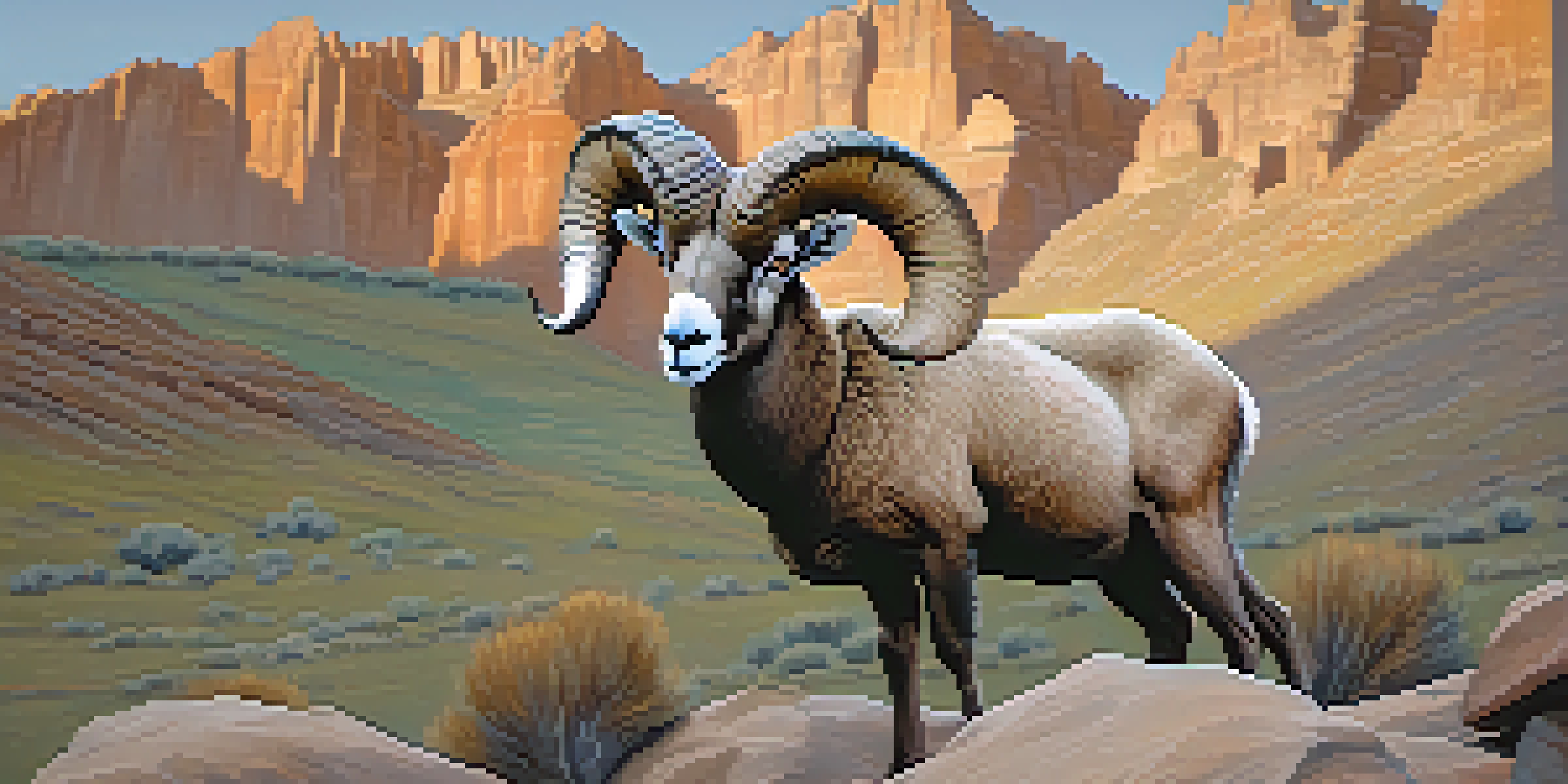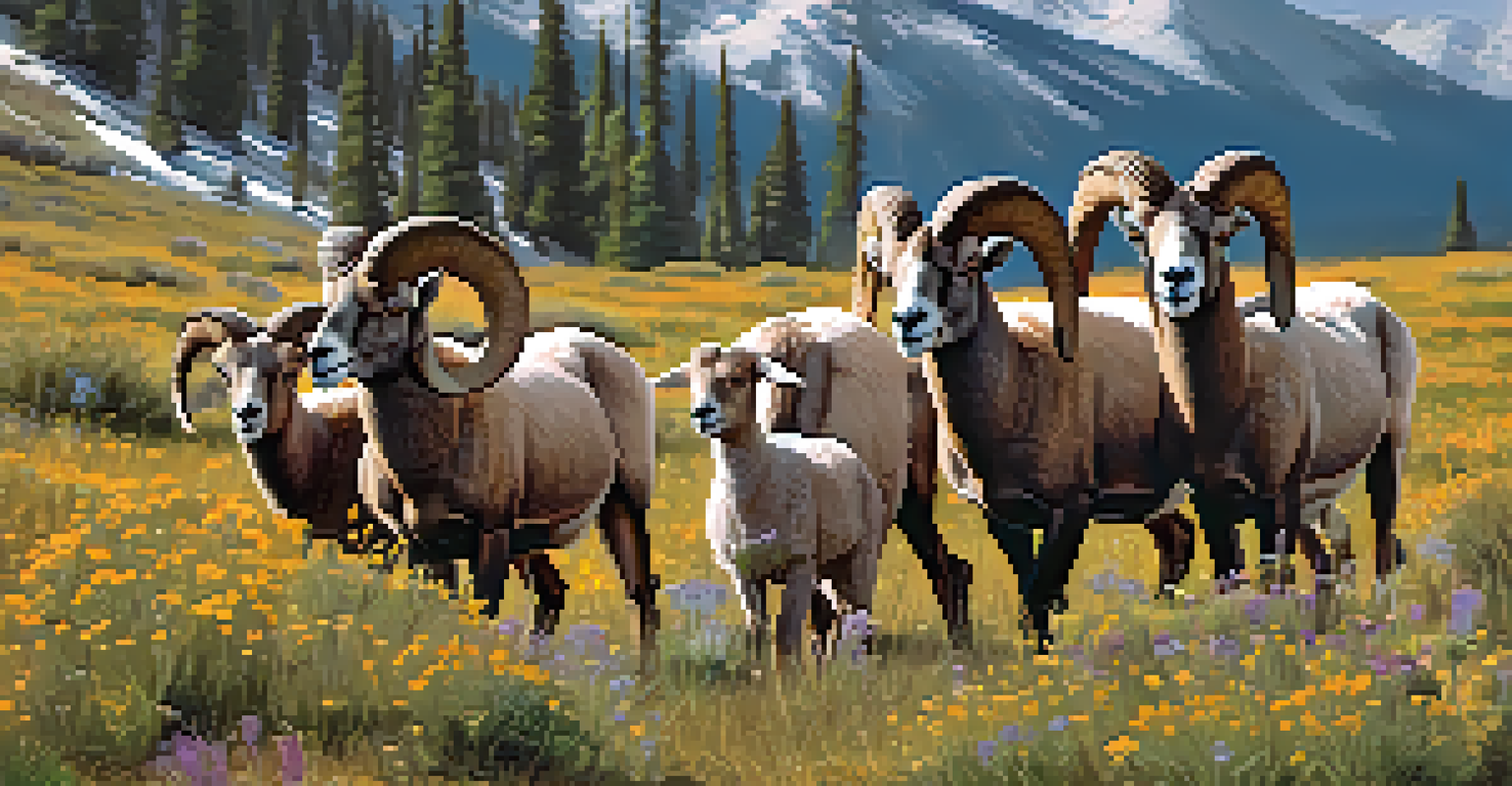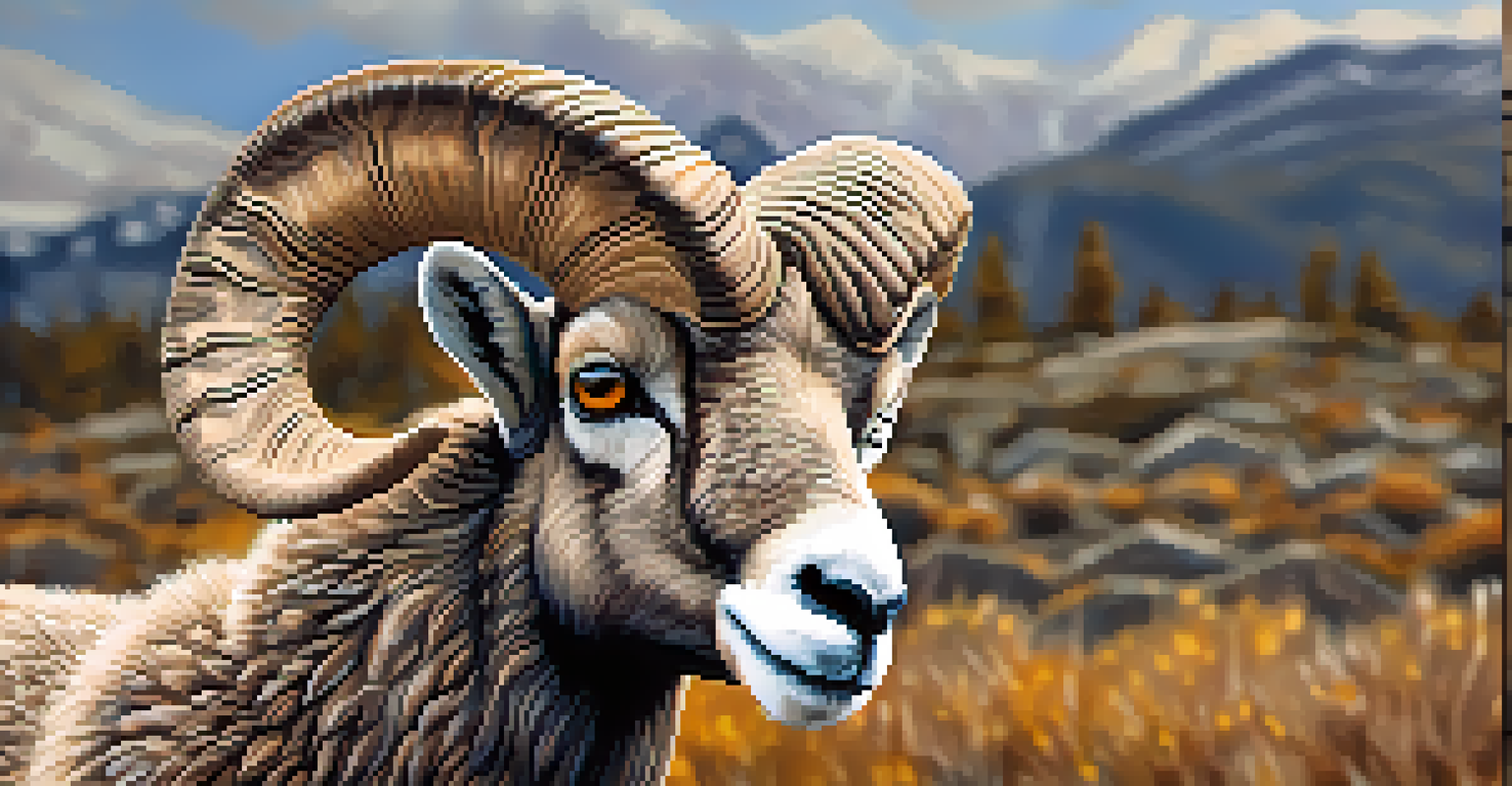Colorado's State Animal: The Rocky Mountain Bighorn Sheep

Introduction to the Rocky Mountain Bighorn Sheep
The Rocky Mountain Bighorn Sheep, known scientifically as Ovis canadensis, is a majestic animal that holds the title of Colorado's state animal. These remarkable creatures are easily recognized by their impressive curved horns and sturdy build, which help them thrive in the rugged terrain of the Rocky Mountains. Their unique adaptations allow them to navigate steep cliffs and rocky landscapes with ease, making them a symbol of strength and resilience in the wild.
The mountains are calling and I must go.
Bighorn sheep are not just a pretty face; they play a vital role in the ecosystem as herbivores. They primarily feed on grasses, shrubs, and other vegetation, which helps maintain the balance of plant life in their habitats. This grazing behavior also supports a diverse range of other wildlife, showcasing the interconnectedness of nature.
In addition to their ecological importance, Rocky Mountain Bighorn Sheep are culturally significant to many Indigenous tribes in the region. They are often featured in stories and artwork, symbolizing courage and endurance, further solidifying their status as a cherished animal in Colorado.
Physical Characteristics of Bighorn Sheep
One of the most striking features of the Rocky Mountain Bighorn Sheep is, of course, their impressive horns. Males, or rams, sport thick, curled horns that can weigh up to 30 pounds, while females, or ewes, have smaller, straighter horns. These horns are not just for show; they are used in battles for dominance during mating season, showcasing the rams' strength and vitality.

In addition to their horns, these sheep have a thick coat of wool that keeps them warm in the harsh mountain weather. Their coloration, which ranges from light brown to gray, helps them blend into the rocky terrain, providing an effective form of camouflage against predators. This natural adaptation is crucial for their survival, especially in the high-altitude environments they inhabit.
Bighorn Sheep's Ecological Role
Rocky Mountain Bighorn Sheep are vital herbivores that help maintain plant diversity in their habitats.
Bighorn sheep also possess powerful legs and hooves that are perfectly designed for climbing and navigating steep rocky surfaces. Their agility and balance allow them to traverse challenging landscapes that would deter most other animals, making them true masters of their mountainous domain.
Habitat and Range of the Bighorn Sheep
Rocky Mountain Bighorn Sheep are primarily found in the mountainous regions of North America, with significant populations in Colorado. They thrive in habitats that offer steep cliffs, rocky outcrops, and open meadows, which provide both shelter and grazing opportunities. These environments are vital for their survival, allowing them to evade predators and find food sources.
In every walk with nature one receives far more than he seeks.
Within Colorado, these sheep are commonly spotted in national parks and wilderness areas, such as Rocky Mountain National Park and the San Juan Mountains. Their preference for high altitudes means they typically reside between 6,000 and 12,000 feet, where the air is thinner and the terrain is challenging but rewarding.
The conservation of their habitat is essential for the ongoing survival of the Rocky Mountain Bighorn Sheep. As urban development and climate change threaten their natural spaces, efforts are being made to protect these areas and ensure that future generations can continue to enjoy the beauty of these magnificent animals.
Behavior and Social Structure of Bighorn Sheep
Rocky Mountain Bighorn Sheep are social animals that typically form groups, known as herds. These herds can consist of ewes and their young, while adult rams often roam independently or in smaller bachelor groups. This social structure is crucial for their survival, as it allows them to work together to find food and protect one another from predators.
During the mating season, which typically occurs in the fall, rams engage in fierce battles for dominance. They clash their horns together in dramatic displays of strength, with the victor earning the right to mate with the females. This competition is not just about physical prowess; it also reflects the health and vitality of the rams, as stronger individuals tend to have more success in attracting mates.
Physical Traits of Bighorn Sheep
These sheep are known for their impressive curled horns and strong legs, enabling them to thrive in rugged mountain terrains.
Outside of the mating season, bighorn sheep communicate through various vocalizations and body language. From soft bleats to assertive posturing, these signals help maintain herd cohesion and establish social bonds, showcasing the complexity of their interactions in the wild.
Diet and Feeding Habits of Bighorn Sheep
The diet of Rocky Mountain Bighorn Sheep primarily consists of grasses, forbs, and shrubs found in their mountainous habitats. They are herbivores, meaning they rely on plant material for nourishment, and their grazing habits play a significant role in maintaining the health of their ecosystems. By selectively feeding on certain plants, they help promote biodiversity and prevent overgrowth.
Bighorn sheep are known for their ability to forage in harsh conditions, often climbing steep slopes to reach desirable vegetation. Their specialized digestive systems allow them to efficiently extract nutrients from tough plant materials, which is essential for surviving in the challenging environments they inhabit. This adaptability is a key factor in their success as a species.
Interestingly, bighorn sheep have been observed engaging in behavior known as 'selective grazing.' This means they choose specific plants based on their nutritional value and palatability. This behavior not only helps them thrive but also supports the health of their habitat by preventing any single species from becoming dominant.
Conservation Efforts for Bighorn Sheep
The Rocky Mountain Bighorn Sheep has faced various challenges over the years, including habitat loss, disease, and competition with domestic livestock. As a result, conservation efforts have become increasingly important to ensure their survival. Organizations and wildlife agencies are actively working to protect their habitats and monitor populations, striving to maintain healthy herds.
One important aspect of these conservation efforts is public education and awareness. By informing the community about the significance of bighorn sheep and their habitats, organizations can foster a sense of stewardship among residents and visitors alike. This support is vital for the success of ongoing conservation initiatives.
Cultural Importance in Colorado
Bighorn Sheep hold significant cultural value, symbolizing strength and resilience in Native American folklore and state identity.
In addition to habitat protection, there are also efforts to manage and monitor bighorn sheep populations to prevent the spread of disease. This includes regular health assessments and research to better understand their needs and behaviors, ensuring that strategies are tailored to support their long-term survival in Colorado.
The Cultural Significance of Bighorn Sheep
The Rocky Mountain Bighorn Sheep holds significant cultural importance in Colorado and among Native American tribes. These sheep are often depicted in folklore and artwork, symbolizing strength, resilience, and the spirit of the mountains. Their presence in the region has inspired countless stories, further deepening their connection to the land and its people.
In addition to their symbolic value, bighorn sheep are also a popular subject for wildlife enthusiasts and photographers. Many visitors flock to Colorado's national parks and wilderness areas to catch a glimpse of these magnificent animals in their natural habitat. This admiration fosters an appreciation for wildlife and encourages conversations about conservation and environmental stewardship.

As the state animal of Colorado, the bighorn sheep is also featured in various state programs and initiatives aimed at promoting wildlife conservation. This recognition serves as a reminder of the importance of protecting not just the bighorn sheep, but all wildlife that contributes to the rich biodiversity of Colorado.